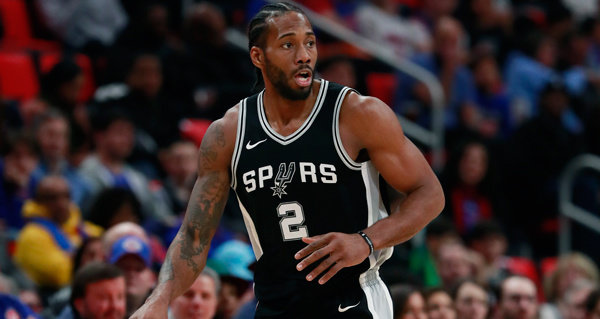Kawhi Leonard is trying to figure out how much his body is worth. The San Antonio Spurs star, despite pleas from his team, has decided to stay off the floor, watching the Spurs do battle without his MVP-level play in the postseason. The tension between Leonard and his team over his return or lack thereof, to the much-debated extent that it exists, puts Kawhi’s body directly into the crosshairs. Not since the eerily similar push-pull that the Chicago Bulls and Derrick Rose had during the 12-13 season have we seen such a direct exhibit of the inherent opposition of organizational planning and individual player health.
With the playoffs looming, Leonard is not the only superstar whose bodily care timeline looks set to fundamentally alter the competitive landscape. Kyrie Irving recently underwent surgery to remove a tension wire in his left knee, and his return schedule of 3-to-6 weeks puts his, and the Boston Celtics’, decision on when he’ll be able to play again squarely during the first or second round. During the same weekend, Stephen Curry was diagnosed with a Grade 2 MCL sprain, with a re-evaluation period set for three weeks later. Steve Kerr has said there’s “no way” Curry will play in the first round.
For the Celtics, Spurs, and Warriors—as for all NBA teams—there is a persistent battle between playing for now and planning for later, and the object that these two concepts volley back forth at each other in their game is very much physical. Leonard’s, Curry’s, and Irving’s bodies are the bargaining chip between each team’s present and future aspirations. The sooner any of them return to boost their team’s playoff performance, the higher the risk that they’ll be compromised players going forward.
Increasingly indifferent to either the team’s present or future, however, are the players themselves. Industries of their own, superstars have begun to more fully appraise where their money is coming from, and they are increasingly disabusing themselves of older definitions of success and glory. While Curry—who ironically suffered his sprain while wearing low tops, provided to him by his other employer of Under Armour, for the first time—has expressed that he hopes to prove his coach wrong and get on the floor as soon as possible, Irving has said no such thing. This, even though all reasonable bystanders see a potential first-round matchup between his Celtics and Giannis Antetokounmpo’s Bucks and wonder whether Boston could survive such a trial without their best player.
One year ago, Isaiah Thomas stood in something like Irving’s shoes, wielding his folklorish isolation heroism at the center of a surprisingly effective Celtics’ offense, stitched together with overlooked component players by Brad Stevens. Despite a shaky health situation, Thomas rode the energy of his dark-horse MVP candidacy into the postseason as he became the most adored player on the Celtics since Paul Pierce and Kevin Garnett were traded to the Nets. Thomas eventually ended up missing the final three games in an Eastern Conference Finals loss to the Cavaliers. After being traded by the Celtics to those same Cavaliers—in a move that should put to rest a whole lot of questions about organizational loyalty; about how little of their body players owe their teams when they are ultimately always reducible to trade bait—Thomas didn’t return to action until January 2018. His rush to re-prove himself after another trade to the Lakers has him undergoing surgery this week for his re-failing hip as he heads into free agency.
In Thomas’ tale of the past two seasons lies a parable that Leonard, and probably Irving too, seems to be learning from. Excepting for the potentially alien LeBron James, NBA bodies are quite finite in what they can endure, and if you overmilk them for the numbers and mythos that lead to more money and fame, those bodies will break. It takes a very modern sort of moxie to deny all the forces, from franchises and fanbases and sponsors, that insist on the continuance of that milking. Leonard is walking a tightrope in this regard, as talks between his representation and Nike over a new, huge shoe contract have reportedly stalled, which would seem not unrelated to the shift in public perception from Kawhi as unstoppable winning machine to Kawhi as strangely beleaguered mystery man, existing within a franchise rarely known for surprises or dissent. Leonard is also eligible for a supermax contract with the Spurs this offseason, which further complicates the situation though it could uniquely provide clarity on where the two sides stand.
Irving, perhaps the shrewdest off-court businessman of his generation, can afford to take the rest of the season off, however. Regardless of how the Celtics fare in the playoffs and regardless of whether he’s a part of that effort, his endorsement deals will be massive and he will be the star of “Uncle Drew” in theaters nationwide late this June. Kyrie has already converted his appeal into a fairly maximized enterprise, a process that Leonard may need to risk his body sooner rather than later to accomplish. In both cases there is much to be said about how superstars balancing the maintenance of their bodies as part of an equation larger and more diverse than what classical sporting lore, which is bent on the immolation of individuals to keep the fire of glory going forward, has prepared us for.



